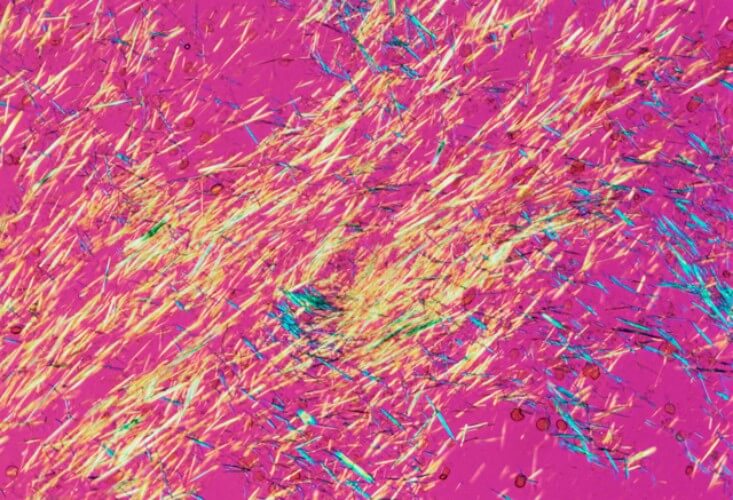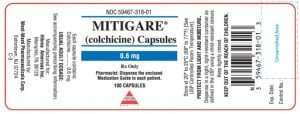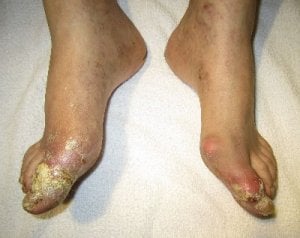Urate crystals commonly referred to as urate deposits, are the second stage of the UDRP process.
This process occurs when the concentration of uric acid increases beyond its saturation point, and crystals form. These urate deposits usually form in and around joints, but are also common under the skin, and may form anywhere in the body.
Uric acid crystals occur in two forms. Temporarily they exist as free-floating crystals, but these are soon coated with products of our immune system. This combination of uric acid and protein coating is called a tophus. But you rarely have only one tophus. So, they are usually referred to as the plural, tophi. Tophi form quite early on in the gout process. But may not become noticeable for several years. Then, once visible, you usually notice progressively harder lumps under the skin. We refer to this type of gouty arthritis as tophaceous gout.
As with most fluids, the crystallization process is temperature dependent. At normal body temperature, crystallization usually occurs when the uric acid level reaches 6.8 mg/dL (0.4 mmol/L). It can occur at lower levels in lower temperatures, and this is the main reason why gout is usually first noticed in the extremities.

The key facts to know about uric acid crystals are:
- In most forms, uric acid crystals are painless, but when free-floating in joint fluid or other tissues, they are attacked as invaders by the immune system. It is that immune process that causes inflammation and pain, and I explain that more fully in the third part of the UDRP gout pain pathway.
- The immune system cannot kill uric acid crystals as it would a virus, so white blood cells surround the crystals to form tophaceous deposits. This process stops the inflammatory response, which is why gout pain goes in a few days unless another attack occurs. However, these deposits grow in and around joints and will cause permanent damage to bone, cartilage, and tendons. Uric acid lowering is crucial to stop this process and to dissolve existing deposits.
- When uric acid concentration decreases, most urate deposits will start to dissolve. This usually happens when uric acid lowering medicine is taken, or lifestyle changes are made to reduce uric acid. As old crystals dissolve, they shed the protein skin that hides them from the immune system. Sufficient numbers of dissolving crystals can trigger an acute attack. This is a fairly common event during the early stages of urate-lowering treatment, and pain relief is usually prescribed alongside allopurinol, febuxostat, probenecid and similar medication. It can also happen when diet changes lower uric acid, which is the reason gout must always be managed according to uric acid test results, and never by the occurrence or absence of pain.
Urate Crystals: Next Steps
See how urate crystals fit into the complete gout picture by browsing the rest of this Uric Acid Section.
Urate Crystals Related Topics
Please remember: to find more related pages that are relevant to you, use the search box near the top of every page.
Common Terms: crystal, tendon, Urate Deposits
Other posts that include these terms:
- Gout Without Hyperuricemia
- Gout & Rheumatoid Arthritis
- Uric Acid Arthritis – Another Name For Gout
- Do you know 9 Golden Rules of Gout Management?
- Uric Acid Crystal Pictures
- Left Foot Tophi Study with Photographs
- Running With Gout – Beware Foot Tendon Damage
Please give your feedback
Did this page help you? If yes, please consider a small donation. Your donations help keep GoutPal's gout support services free for everyone.
If not, please tell me how I can improve it to help you more.
- YouTube
- The gout forums.









